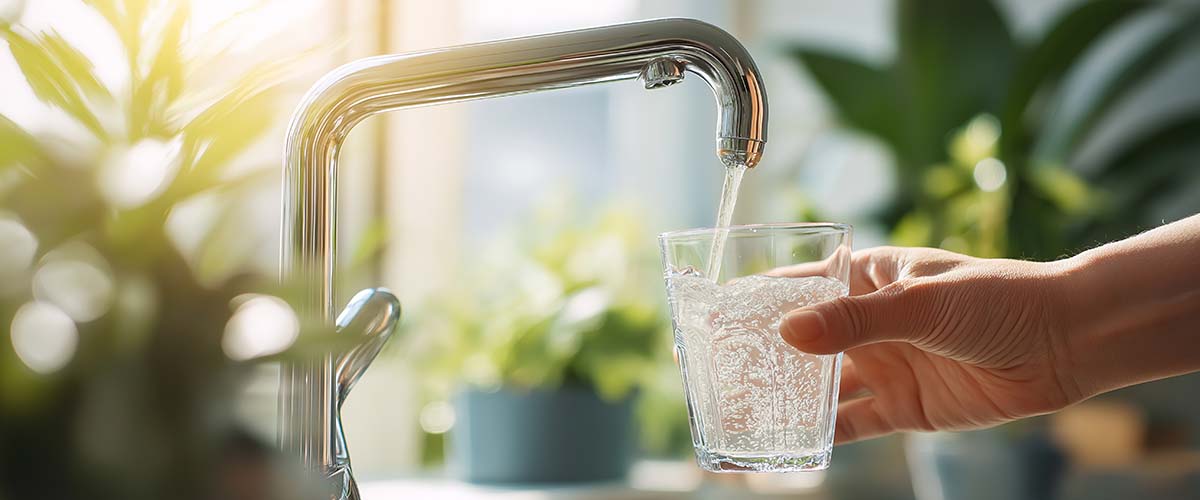The kitchen faucet pours out chalky-looking water that makes your coffee foggy. Most of the time, it’s just microbubbles—air, not milk. After two decades under Winston-Salem sinks with PF Plumbing, I’ve seen this happen in old West End bungalows and brand-new homes. Cold snaps, city pipe work, and even a water heater burp can all cause temporary haziness. Here’s how to test, fix, and know when it’s time to call a pro.
What Can Cloudy Water Be Used For?
If the haze clears in a clear glass within 1–3 minutes—bottom up like soda going flat—it’s just air. That water is safe for drinking, cooking, and even making baby formula.
If the cloudiness lingers longer than five minutes or the water looks yellow, brown, or smells like sulfur, don’t drink or cook with it until it’s resolved. Boiling won’t remove minerals or metals. Use bottled water for formula, coffee, pets, and aquariums in the meantime.
For produce, microbubbles are harmless. But if the water has grit or odor, rinse with filtered or bottled water. I once had a call where the first burst after vacation smelled like wet dog; after flushing the lines for two minutes, it cleared up.
Fixing Common Problems That Cause Cloudy Water
Glass test: Fill a clear glass and set it down. If the haze clears from the bottom up in 1–3 minutes, it’s air.
Bleed air: Open the lowest cold faucet in the house (usually a basement sink or tub). Run it full blast for two minutes, then repeat upstairs.
Clean aerators: Unscrew faucet tips, rinse the screens, and soak in white vinegar for 15 minutes before reassembling.
Check the water heater: If only the hot side is cloudy, drain a few gallons into a bucket until it runs clear. Flush the tank if possible and keep the thermostat at 120°F. If hot water smells like sulfur, the anode rod may need replacing.
Check pressure: Hook a gauge to a hose bib. Most homes sit around 50 PSI. Readings above 80 PSI can whip air into the line and stress fixtures.
After city’s main work: Expect bubbles for a day. If it doesn’t clear after flushing faucets for 15 minutes, call the utility.
Cleaning and Maintenance to Prevent Cloudy Water
Regular upkeep keeps haze at bay. Clean faucet aerators every few months by soaking them in vinegar and scrubbing off buildup. Replace any worn or crumbling screens.
Flush the water heater annually (twice a year in hard-water areas) to prevent sediment. I’ve opened heaters that looked like snow globes, with calcium flakes drifting like confetti.
Replace whole-house or under-sink filters on schedule. Old cartridges can break down and mimic cloudiness. If you have a softener, check salt levels and run a manual regeneration now and then.
Inspect your pressure regulator (PRV). Attach a gauge and check the static reading. Aging PRVs often let pressure creep higher, which stirs up air bubbles and adds wear on fixtures. After vacations, run faucets for 30 seconds to flush stale water that may appear hazy.
When Does Cloudy Tap Water Need Professional Help?
Call a plumber if the haze doesn’t clear in a glass within five minutes. Water that’s yellow, orange, or tea-brown—or has grit—may mean galvanized pipe corrosion or sediment from the main. We can flush lines and collect samples.
If only hot water is cloudy, with a rotten-egg smell or fizz, it likely points to water heater issues. We can flush the tank, check the dip tube, or replace the anode rod.
If pressure exceeds 80 PSI, it can churn bubbles all day and damage valves. We replace PRVs and reset them to safe levels. Strange sounds like banging or hollow thuds are also warning signs.
For wells, persistent haze can indicate turbidity or gas. We test for particulates and bacteria and set up proper filtration. For city water, cloudiness after a main break should clear after flushing. If not, we coordinate with the utility and install point-of-entry filtration.
Bottom line: if water looks wrong, smells odd, or leaves you uneasy, call for a quick test. It’s better than guessing.
Frequently Asked Questions About Cloudy Tap Water
Is cloudy or milky tap water safe to drink?
Usually, yes, if it clears from the bottom and has no odor.
Why is only my hot water cloudy?
Heaters trap air and stir sediment. Flushing and checking the anode rod usually solves it.
How long should I run the tap to clear the air?
Two minutes at the lowest faucet is usually enough.
Will a fridge filter help?
It may polish minor haze, but air bubbles just need time to settle.
Do I need a softener?
If scale builds up on fixtures and haze persists, a softener can help with minerals.
Who do I call first—the city or a plumber?
If neighbors have cloudy water too, start with the utility. If not, call us.

